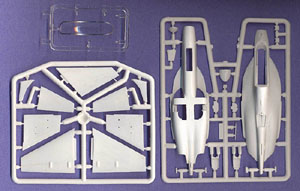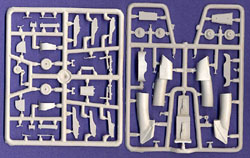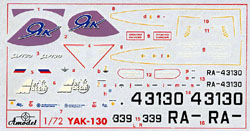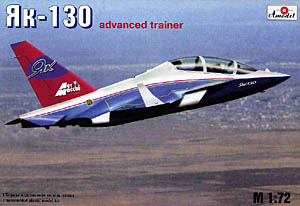Amodel's 1/72 Yak/AEM-130 | | History Throughout much of the Cold War era, the Soviet Union farmed out military trainer production to its Warsaw Pact allies - the most important being the Czech Aero Vodochody firm, which churned out hundreds of L-29 Delphins and L-39 Albatrosses. The collapse of the Communist regimes in the early 90's coincided with the need for a new technology replacement for the aging fleet of Soviet Albatrosses, and the new economic realities meant that the new trainer had to be a Russian product. Desperate for business, the Soviet aviation companies fought hard to design and produce the new trainer. Two of the Old Guard companies, MiG and Yakovlev, were selected to cut metal with their designs. The MiG design was conservative - straight wings and a simple tandem fuselage with simple intakes on the sides - nothing that would look out of place in a line-up of Hawks, Alphas and other 70's era jet trainers. Yakovlev's design, on the other hand, featured delta wings with winglets, and a blended fuselage with sophisticated swoopy lines that wouldn’t look out of place on a Formula 1 racer or in a Star Wars movie. Italy's Aermacchi, itself working on a new generation trainer, was quick to appreciate the Yakovlev design, and a collaborative agreement was signed in 1993. Aermacchi got technical access and rights to market the plane outside of Russia. Yakovlev got money and access to Aermacchi's marketing savvy. The prototype first flew in April 1996. Performance is brisk; with a top speed around 640 mph. Aerodynamic, weapon system, and avionics development proceeded in Italy and Russia for four years, but the necessary frugality of the New Russia slowed the pace of the development work. Things came to a head in the summer of 2000 - the arrangement was modified to allow Aermacchi to proceed alone with a sophisticated all-Western version of the plane. This version is now called the Aermacchi M-346, and first flight is expected in mid 2002.  The Kit The Kit Amodel is a Ukrainian company with a talent for picking appealing subjects and a better distribution network than many of their Eastern competitors (at least here in the Northwest). Unfortunately, many of their kits have been rather crude - just on the borderline of buildability. I'm happy to report that this kit seems a quantum move up for Amodel. The kit represents the mid 90's appearance of the plane. Recent photos show a much larger horizontal stabilizer, and the cool winglets seem to have disappeared. The kit's accuracy is a tough call. The kit's wingspan measures out within a couple of millimeters of published dimensions; the length might be a few millimeters short. Proportions and shapes look fine to my eye, though the blended wing-body make it hard to gauge. The canopy may be a tad shallow.  This kit consists of 4 white sprues and one clear one. This plastic lacks that soapy consistency and sawdust and rat-hair contamination of earlier kits. The usual pre-wash in dish soap will be required. Flying surfaces are commendably thin. Recessed panel lines are sparse, as befitting a sleek modern design, and are reasonably straight and of consistent depth. We're not talking Tamiya-like here - those who enjoy cleaning up those crude Eastern European parts will still find some uses for the putty and fine sandpaper. But nothing like the "fill everything then re-scribe everything" experience of older Amodels. Sprue connectors are NOT ridiculously thick, and my example has no warped or lumpy parts. This kit consists of 4 white sprues and one clear one. This plastic lacks that soapy consistency and sawdust and rat-hair contamination of earlier kits. The usual pre-wash in dish soap will be required. Flying surfaces are commendably thin. Recessed panel lines are sparse, as befitting a sleek modern design, and are reasonably straight and of consistent depth. We're not talking Tamiya-like here - those who enjoy cleaning up those crude Eastern European parts will still find some uses for the putty and fine sandpaper. But nothing like the "fill everything then re-scribe everything" experience of older Amodels. Sprue connectors are NOT ridiculously thick, and my example has no warped or lumpy parts.
Most of the small detail parts will require some clean up, but all appear useable. The large canopy is clear, a bit thick, and nicely molded on the outside surface. The mold makers should have spent more time cleaning up the inside, though - there are visible scratches and striations that will distort views of the cockpit. Perhaps fine sanding and polishing will help; if not, heat smashing a newer canopy looks easy. The cockpit is a simplified affair with nine parts total. Since the large canopy allows (hopefully) a good view of the cockpit, many modelers will want to use scrap and spare decals to improve the area. The inlets and intake ducting build up into complex assemblies that are fed through openings in the bottom fuselage. This looks like a possible tough task, but a friend who's done it says that everything will eventually fit.  Decals are for the plane's first scheme. The red pinstripe that runs down the fuselage is not on the sheet, calling for some spare decal rummaging or some very fine masking. The decals look thin and nicely drawn, but the ink's a bit thin in spots. Some touch up with a fine brush will help. They have an inappropriate matte finish, calling for some Glosscote or Future. Such an overcoat would also serve to prevent a possible occurrence of the dreaded Exploding Eastern Decal Syndrome. Decals are for the plane's first scheme. The red pinstripe that runs down the fuselage is not on the sheet, calling for some spare decal rummaging or some very fine masking. The decals look thin and nicely drawn, but the ink's a bit thin in spots. Some touch up with a fine brush will help. They have an inappropriate matte finish, calling for some Glosscote or Future. Such an overcoat would also serve to prevent a possible occurrence of the dreaded Exploding Eastern Decal Syndrome.
Conclusion As with most Eastern kits, putty and patience are required. But opening the box for the first time reveals more good news than bad. This is a very attractive airplane, in beautiful colors, and the kit is good enough to invite building. It made me want to reach for my X-Acto knife, and that is a big leap for Amodel. References | 


 



  
    |

 The Kit
The Kit This kit consists of 4 white sprues and one clear one. This plastic lacks that soapy consistency and sawdust and rat-hair contamination of earlier kits. The usual pre-wash in dish soap will be required. Flying surfaces are commendably thin. Recessed panel lines are sparse, as befitting a sleek modern design, and are reasonably straight and of consistent depth. We're not talking Tamiya-like here - those who enjoy cleaning up those crude Eastern European parts will still find some uses for the putty and fine sandpaper. But nothing like the "fill everything then re-scribe everything" experience of older Amodels. Sprue connectors are NOT ridiculously thick, and my example has no warped or lumpy parts.
This kit consists of 4 white sprues and one clear one. This plastic lacks that soapy consistency and sawdust and rat-hair contamination of earlier kits. The usual pre-wash in dish soap will be required. Flying surfaces are commendably thin. Recessed panel lines are sparse, as befitting a sleek modern design, and are reasonably straight and of consistent depth. We're not talking Tamiya-like here - those who enjoy cleaning up those crude Eastern European parts will still find some uses for the putty and fine sandpaper. But nothing like the "fill everything then re-scribe everything" experience of older Amodels. Sprue connectors are NOT ridiculously thick, and my example has no warped or lumpy parts.  Decals are for the plane's first scheme. The red pinstripe that runs down the fuselage is not on the sheet, calling for some spare decal rummaging or some very fine masking. The decals look thin and nicely drawn, but the ink's a bit thin in spots. Some touch up with a fine brush will help. They have an inappropriate matte finish, calling for some Glosscote or Future. Such an overcoat would also serve to prevent a possible occurrence of the dreaded Exploding Eastern Decal Syndrome.
Decals are for the plane's first scheme. The red pinstripe that runs down the fuselage is not on the sheet, calling for some spare decal rummaging or some very fine masking. The decals look thin and nicely drawn, but the ink's a bit thin in spots. Some touch up with a fine brush will help. They have an inappropriate matte finish, calling for some Glosscote or Future. Such an overcoat would also serve to prevent a possible occurrence of the dreaded Exploding Eastern Decal Syndrome. 






